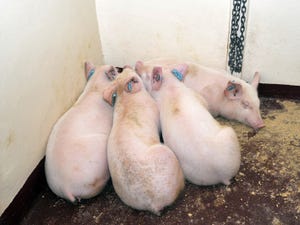Tips to improve sow health, longevity
Train employees to identify, intervene early on in the disease process to help mitigate health challenges.
April 10, 2024

Sow mortality continues to be a growing problem for U.S. swine producers. With already thin margins on sow farms, the ability to raise a gilt into a healthy third-parity sow is necessary to recoup the costs of her development.
“Over the last handful of years, sow mortality has been excessive, but in 2023, it was particularly bad,” says Adam Gutierrez, senior account manager with Pharmgate Animal Health. “We saw 15.3% sow mortality, a 1% increase from the previous year, according to MetaFarms."
The trickiest part of sow mortality is that many factors contribute to it. Thankfully, through employee training, it’s easier to identify early illness and lameness. Use these tips to improve sow health and longevity.
Train employees to observe and explain
Identifying the early stages of illness or lameness issues gives you a higher chance of seeing success with treatment and improving long-term health. The key to catching health issues early is knowing what to look for and teaching your employees to catch these signs.
Training should include a variety of things — how to observe sows and gilts in their natural state, identifying the early signs of lameness and illness, and what to do once an issue appears.
“When addressing sow mortality, I have seen the most success when individual farms teach their employees about these early signs,” says Gutierrez. “They should be able to monitor sows' health and recognize disease early before they become a larger issue.”
Employees must record their observations for continuity of care with other team members. They also need to convey those observations to veterinarians so proper treatment can happen as quickly as possible.
Look for the abnormal
Monitoring the feed trough is one of the easiest ways to determine whether a sow is suffering from a disease or lameness. If something is wrong, she will likely stop eating or eat less.
Abnormal behavior, such as a sow or gilt distancing herself from the herd, could also indicate she’s dealing with a health-related issue.
“When monitoring sows, the key is to observe them in their natural state,” says Gutierrez. “The moment you enter the pen, sows will act differently. Do what you can not to disturb them.”
Focus on feet and legs
A third of sow death loss is due to lameness and downers.[1] Lameness-related mortality tripled from 2005 to 2016.[2] Noticing lameness early is critical for sow comfort and welfare.
“In group housing, train your employees to walk behind and in front of sows. Look for any traits that indicate lameness,” says Gutierrez. “In the gestation stall, look for a sow favoring a leg or a swollen joint. While it can be harder to see, a sow will not put weight on a leg when lame. Lameness is so easy to miss if you only walk in front of sows.”
Provide the right environment
Being in the right environment during farrowing and when dealing with illness improves a sow’s chances of reaching three parities and beyond.
“The best first treatment for any health issues is to remove the sow from her current environment,” says Gutierrez. “Give her a quiet place to be treated so she can recover fully.”
A sow also needs a low-stress environment during farrowing. In addition to a smoother farrowing experience, a calm sow has better nursing behaviors, and her piglets perform better.[3]
Train your employees to monitor her throughout farrowing without disturbing her. Ideally, an employee should check on a sow every 15 minutes, with at most 30 minutes between monitoring sessions. If you are not observing farrowing progress within 15 minutes, assess the situation and assist her as necessary.
Sow mortality continues to be a concern for swine producers, but training employees to identify and intervene early on in the disease process can help mitigate health challenges.
References
[1] Dekkers J, Iowa State University, PigX Livability Podcast, Season 3, Episode 3, Genetic Resilience in Swine, https://piglivability.org/podcast
[2] Ketchum R, 30 & up Consulting LLC, PigX Livability Podcast, Season 2, Episode 9: Survivability and the Sow. https://piglivability.org/podcast
[3] Baxter, EM, Hall, SA, Farish, M, Donbavand J, Brims M, Jack M, Lawrence A, Camerlink I, 2023, Piglets’ behaviour and performance in relation to sow characteristics. Animal 17(2)
You May Also Like



